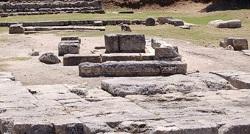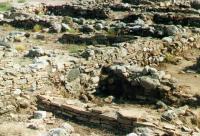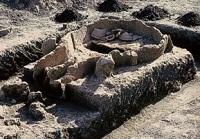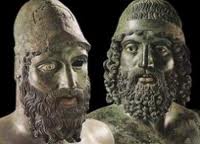
|
||||||||||||||||||||||||||||||||||||||||||||||||
|
||||||||||||||||||||||||||||||||||||||||||||||||
|
|
Archaelogy
 Part of Calabria's archeological patrimony has already been identified or excavated, but part still awaits discovery. Part of Calabria's archeological patrimony has already been identified or excavated, but part still awaits discovery.
The abundance of remains in the region is the result of close links with Greece, followed by the Roman conquest. Calabria has appropriately been described as an open-air museum; on the Ionian side, hardly a place exist where archeological finds have not been brought to light or are , predictably, still awaiting discovery.
A rich abundance of examples is to be found in the archeological and antiquities museums at Reggio, Vibo, Crotone, and Sibari, as well as, to a lesser extent, in the civic and provincial museums.
Calabria already had its own remarkable culture before the Greeks came; from the Villanovian necropolis, it is known that cremation was practiced and that the population made red terracotta and used iron and bronze weapons, as well as gold, silver and amber objects.
With the arrival of the Greeks, native methods merged amicably with the new, without absolute imposition of the Greek model. This is evident in the wide differences between pottery discovered in Puglia, calabria and the part of Lucania towards the Ionian Sea, differences which are invariably attributable to the underlying Italiot tradition.
Temples - We shall first describe the mainly ruined and thus less picturesque temples, barely above ground level.
 Of the Temple of Caulonia, at the foot of the Punta Stilo hill, part of the surrounding wall, the base of the Doric column and the foundations of nobles houses remain. Of the Temple of Caulonia, at the foot of the Punta Stilo hill, part of the surrounding wall, the base of the Doric column and the foundations of nobles houses remain.
Under Punta Stilo lie the foundations of the baths;the mosaic is in Reggio Museum.
Particularly elegant, though regrettably the sole survivor, is the Doric column from the Temple of Hera Lacinia, at Crotone, or to be exact, Capo Colonna, by the sea; part of the walls and rooms in opus reticulatum can still be seen.
The town of Locri was studied by Von Riedsel Sain-Non and Bielynski in the 18th century ( Bielynski's is the first plan).
In the 19th century,Froncois le Normand complained officially that ancient material was being used to build modern Locri. Shortly after Paolo Orsi, the archeologist, who discovered the whole of the Greco-Roman Calabria, began digging (1898).
 The ruins of the Ionic Temple of Marasa' (end 7th-early 6th century BC) are still visible. The ruins of the Ionic Temple of Marasa' (end 7th-early 6th century BC) are still visible.
The name derived from the Greek Byzantine word meaning "where fennel grows", for the actual dedication of the temple is unknown.
This is a highly important site, since till 1889, it had been thought that all the temples (Paestum, Selinunte and Agrigento ) where Doric, and only at a later date were Ionic columns discovered at Agrigento.
In the ruins of the more recent Doric Temple of Zeus (or Casa Marafioti), 39 bronze tablets describing daily life in the sanctuary were found.
This find is the most important of its kind in relation to ancient greece. Some distance away, a number of pinakes, votive terra cotta tablets dedicated to Persephone, were found.They indicate the likely existence on the spot of a temple to this goddess greatly worshipped at Locri.
 Some researchers feel that such a temple did not exist, being an open-air cult. Tablets land pinakes are now in the Reggio Museum. Some researchers feel that such a temple did not exist, being an open-air cult. Tablets land pinakes are now in the Reggio Museum.
The theater with steps of the local, friable rock lies in the hills; nearby stands Centocamere, a name frequently given to archeological digs comprising a maze of chambers. This is an interesting example of rare private construction; many houses have an oven, so this might have been an artisan ( there are clay mountains in this area, and at Gerage, kilns in caves are still in use ) or sacred area.
Votive and religious objects have been found at Locri; for example, the Dioscuri group, in which Phidian influence can be seen ( according to De Franciscis, this was placed for decorative purposes over the frontal of the Marasa' temple), and the nude youth seated on a sphinx, from the Temple of Zeus.
Both of these fine sculptures are now in Reggio Museum.
Terra cotta: The Locri terra cotta have already been described, however, another numerous group comes from Medma-Rosarno, on the Tyrrhenian coast. These objects are more ornate than the greek ware, and the influence of great Klarcos and Pythagoras is apparent.
Several tombstones dating to 1 rst century BC have also been discovered recently in the area. Other smaller groups are in Caulonia, Crotone and Sibari.
 Ancient Sybaris : Apart from the Locri sites, mention must be made of the Sibari Quarters. The archeological area at Sibari was not identified untill 1989, but now the Stombi quarters, where the archeological level is about 2 m below sea level can be visited. Ancient Sybaris : Apart from the Locri sites, mention must be made of the Sibari Quarters. The archeological area at Sibari was not identified untill 1989, but now the Stombi quarters, where the archeological level is about 2 m below sea level can be visited.
Other areas being explored are the Parco del Cavallo, the street extension, in the Casa Bianca and the crossroads.
The average tourist might be disappointed since the excavations are mainly of professional interests, and seem little or more than a series of roads and foundations.
It is really important to visit the Exhibition before the site.
Coins - Jewellery - Mirrors - Amphorae - Pots are found in in large numbers,over the whole Calabria. Important pieces
( 4th and 5th century AD ) are iIron Age coffers, and the Tresilico glass cup found at Castellace, near Oppidio Marmertina (Reggio) with a hunting scene on sheet gold. Those interested in archaeology, must not miss the Reggio Archaeological Museum (46 rooms)
 The Bronzes of Riace : In August 1972, by sheer chance, two bronze statues were spotted lying on the sandy sea bed at Porto Forticchio, near Riace. The Bronzes of Riace : In August 1972, by sheer chance, two bronze statues were spotted lying on the sandy sea bed at Porto Forticchio, near Riace.
Each roughly two meters high, they were landed amid the curiosity and enthusiasm of the holiday makers present.
This was but the beginning of their travels. Nine years later they were exhibited to the public in Florence where they had been restored, then in the Quirinal Palace in Roma and lastly in the Magna Grecia Museum in Reggio di Calabria ... learn more >>>
You might also be interested to learn about : Calabria Ethnic minorities | Calabria Grecanica | Traditions & Folklore | Costumes of Calabria | Traditions and Progress | A culture of skills | Art in Calabria | Archaelogy |
|

|
||||||||||||||||||||||||||||||||||||||||||||||
|
||||||||||||||||||||||||||||||||||||||||||||||||
